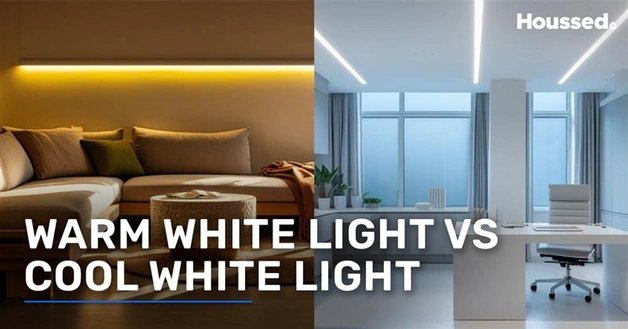Warm White Light Vs Cool White Light: Which One is Better?

Lighting plays a vital role in shaping the ambience of a space. The colour temperature of light, particularly the choice between warm white and cool white, can significantly impact your mood, comfort, and even productivity.
In this guide, we'll explore warm white light vs cool white light, helping you select the ideal lighting tone to enhance the overall style of your home or office.
What Is Warm White Light?
Warm white light typically falls within the colour temperature range of 2000K to 3000K. This tone mimics the soft glow of traditional incandescent bulbs. It has a yellowish hue that creates a cosy, intimate environment.
Warm white is ideal for relaxing spaces, such as living rooms and bedrooms, as it promotes calmness and comfort. It also enhances natural wood tones and earthy colour schemes, making interiors feel welcoming.
What Is Cool White Light?
Cool white light usually ranges from 3000K to 4500K. This light has a crisp, bluish tone and delivers better visual clarity. It resembles natural daylight and is commonly used in areas that require focus and alertness.
Cool white enhances modern decor with neutral or monochrome palettes and works well in kitchens, bathrooms, offices, and garages. It’s efficient for task lighting and promotes productivity.
Also Read - Feng Shui Coins
What is LED Colour Temperature?
Colour temperature is measured in Kelvin (K) and ranges from 1000K to 10,000K, determining the appearance of light emitted from a bulb. Lower temperatures (under 3000K) are warmer, while higher temperatures (above 4000K) are cooler.
|
Temperature (Kelvin) |
Colour Description |
Common Use |
|
2700K |
Soft Warm White |
Bedrooms, Living Rooms |
|
3000K |
Warm White |
Dining Rooms, Hallways |
|
4000K |
Neutral/Cool White |
Bathrooms, Kitchens |
|
5000K |
Daylight |
Offices, Garages, Workspaces |
|
6000K+ |
Cool Daylight |
Outdoor Security, Display Lighting |
Difference Between Warm White Light vs Cool White Light
The table breaks down the differences between warm white light vs cool white light, highlighting their key differences in colour temperature, ambience, and ideal usage areas.
|
Feature |
Warm White Light (2000K–3000K) |
Cool White Light (3000K–4500K) |
|
Colour Hue |
Orange, Soft Yellow/Amber |
Bright Blue/White |
|
Mood |
Relaxing, Cosy |
Energetic, Alert |
|
Best For |
Bedrooms, Living Rooms, Dining Areas, Garden Lighting |
Offices, Kitchens, Bathrooms |
|
Visual Clarity |
Lower |
Higher |
|
Ambience |
Traditional, Warm |
Modern, Clean |
|
Complementary Styles |
Rustic, Classic, Vintage |
Minimalist, Contemporary |
Also Read - Laughing Buddha
Best Areas in the Home for Warm White Light
- Living Room: Use warm white lighting to create a welcoming atmosphere that encourages relaxation and entertaining. Consider using table lamps, floor lamps, and warm ceiling fixtures.
- Bedroom: Soft, warm white lighting helps ease the mind and prepare the body for sleep. Use bedside lamps, wall sconces, or dimmable overhead lights for a cosy ambience.
- Dining Room: Warm lighting enhances food presentation and creates a cosy environment for meals and conversations.
- Entries & Hallways: Warm white helps maintain continuity with surrounding living areas, creating a smooth and inviting transition into the home.
Best Areas in the Home for Cool White Light
- Workspace: Cool white lighting improves concentration and minimises eye strain, ideal for study desks, offices, or home workstations.
- Bathroom & Toilet: Cool white offers clarity for grooming, shaving, and makeup application. It closely resembles daylight, helping with accurate reflection.
- Kitchen: Use cool white for bright, clean visibility while cooking. Install under-cabinet strips or ceiling LED panels for optimal brightness.
- Cupboard: Cool white lighting ensures visibility and helps locate items easily, especially in walk-in closets or deep storage areas.
Using Warm and Cool Lighting in Your Outdoor Areas
In outdoor areas, both light tones can be used strategically:
- Warm White: Ideal for patios, porches, and garden paths. It creates a welcoming ambience and blends well with natural surroundings.
- Cool White: Best for security lighting, driveways, and garage exteriors. It enhances visibility and discourages intruders.
Also Read - Wind Chimes Vastu
Pros and Cons of Warm White Light and Cool White Light
When choosing warm white light vs cool white light, it is essential to understand their pros and cons.
Pros and Cons of Warm White Light
|
Pros |
Cons |
|
Warm white light brings an inviting glow that enhances comfort and relaxation |
These lights appear dim, reducing visibility for detailed tasks |
|
Generally, it is easier on the eyes, especially for prolonged periods |
It is not suitable for tasks requiring high colour accuracy |
|
Enhance better sleep by inhibiting the production of melatonin at night |
This light is not suitable for morning hours when alertness is required |
|
Modern, warm white LEDs offer excellent energy efficiency while maintaining a cosy glow |
The light's efficiency is slightly lower than cool white LEDs of the same brightness |
Pros and Cons of Cool White Light
|
Pros |
Cons |
|
Enhance concentration and alertness, perfect for task areas |
Relaxation areas can often feel harsh and sterile |
|
Creates a clean and modern atmosphere |
The excessive brightness of white light can lead to eye strain over prolonged periods |
|
Slightly more efficient than warm white LEDs of the same brightness |
The cost of white light is slightly higher than incandescent bulbs. |
Summary
What Is Warm White Light?
Warm white light (2000K–3000K) has a soft, yellowish hue that mimics the colour of incandescent bulbs. It’s perfect for creating a cosy, calming atmosphere in spaces like living rooms and bedrooms, and it complements warm, earthy interiors.
What Is Cool White Light?
Cool white light (3000K–4500K) has a crisp, bluish tone that resembles daylight. It’s ideal for task-oriented spaces like kitchens, bathrooms, and offices, enhancing focus, visual clarity, and productivity while complementing modern decor.
What Is LED Colour Temperature?
LED colour temperature, measured in Kelvin (K), defines how warm or cool the light appears. Lower values (under 3000K) produce warm, yellowish light, while higher values (above 4000K) emit cool, bluish light.
Difference Between Warm White Light vs Cool White Light
- Warm white light (2000K–3000K) gives a soft, yellowish glow ideal for cosy, traditional spaces like bedrooms and living rooms.
- Cool white light (3000K–4500K) emits a bright, bluish tone, ideal for modern, task-focused areas such as kitchens and offices.
Best Areas in the Home for Warm White Light
- Living Room
- Bedroom
- Dining Room
- Entries & Hallways
Best Areas in the Home for Cool White Light
- Workspace
- Bathroom & Toilet
- Kitchen
- Cupboard
Using Warm and Cool Lighting in Your Outdoor Areas
Use warm white light for patios, porches, and garden paths to create an inviting atmosphere. Select cool white light for driveways, garages, and security lighting to enhance visibility and improve safety.
Pros and Cons of Warm White Light
- Pros: Creates a relaxing atmosphere; gentle on the eyes; supports better sleep; energy-efficient with modern LEDs.
- Cons: Less suitable for detail work or tasks needing high colour accuracy; appears dimmer; not ideal for boosting morning alertness.
Pros and Cons of Cool White Light
- Pros: Boosts focus and alertness; ideal for task areas; offers a clean, modern look; slightly more energy-efficient than warm white LEDs.
Cons: Can feel harsh in relaxing spaces; may cause eye strain over time; slightly costlier than traditional incandescent bulbs.
FAQ's
Warm white emits a yellowish tone (2000K–3000K), ideal for relaxing spaces. Cool white emits a bluish tone (3000K–4500K), enhancing focus and clarity.
Warm white is better for relaxation as it creates a soothing, cosy ambience that signals the brain to wind down.
Yes, use warm white in living areas and bedrooms, and cool white in task-oriented spaces like kitchens and bathrooms for optimal functionality.
Yes, cool white light enhances focus and reduces eye strain, making it ideal for reading, studying, or working.
Warm white lights generally consume more electricity than cool white lights due to differences in manufacturing processes, materials used, and the way the light is emitted.
Cool white light complements minimalist and modern designs with neutral palettes, while warm light suits classic or rustic styles.
To choose between warm and cool white lighting for your new home, follow these essential tips:
- Consider the desired ambience
- Functionality of the space
- Personal preference
Yes, warm white supports melatonin production and helps the body prepare for sleep, especially during evening hours.
Yes, use warm white for ambience and cool white for security or task-based outdoor lighting to achieve balanced functionality.
For home use, warm white is a better choice as it creates a relaxing atmosphere, perfect for living rooms, dining rooms and bedrooms.









